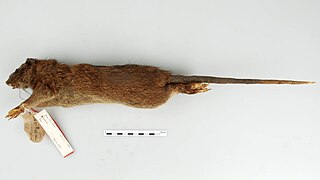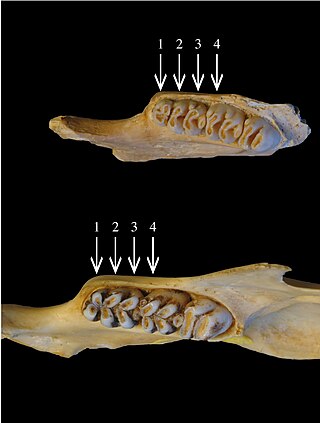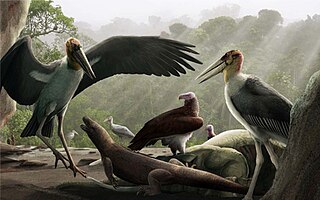
Flores is one of the Lesser Sunda Islands, a group of islands in the eastern half of Indonesia. Administratively, it forms the largest island in the East Nusa Tenggara Province. Including Komodo and Rinca islands off its west coast, the land area is 14,731.67 km2, and the population was 1,878,875 in the 2020 Census ; the official estimate as of mid-2023 was 1,962,405. The largest towns are Maumere and Ende. The name Flores is of Portuguese origin, meaning "Flowers".

Homo floresiensis( also known as "Flores Man") is an extinct species of small archaic human that inhabited the island of Flores, Indonesia, until the arrival of modern humans about 50,000 years ago.

Stegodon is an extinct genus of proboscidean, related to elephants. It was originally assigned to the family Elephantidae along with modern elephants but is now placed in the extinct family Stegodontidae. Like elephants, Stegodon had teeth with plate-like lophs that are different from those of more primitive proboscideans like gomphotheres and mammutids. The oldest fossils of the genus are found in Late Miocene strata in Asia, likely originating from the more archaic Stegolophodon, subsequently migrating into Africa. While the genus became extinct in Africa during the Pliocene, Stegodon remained widespread in South, Southeast and East Asia until the end of the Pleistocene.

The Flores giant rat is a rodent of the family Muridae that occurs on the island of Flores in Indonesia. It has been recorded in Rutong Protection Forest. The species is found in primary, secondary and disturbed forest over a wide range of elevations. Its head and body length is 41–45 cm (16–17.5 in) and its tail length is 33–70 cm (13–27.5 in). These dimensions are about twice as large as those of a typical brown rat, which suggests about eight times the body mass.

Papagomys is a genus of very large rats in the tribe Rattini of the subfamily Murinae, with body masses of 600–2,500 grams (1.3–5.5 lb). It contains two species, which are known only from the Indonesian island of Flores:

Verhoeven's giant rat is an extinct rat of subfamily Murinae that lived on Flores in Indonesia. It was judged to be extinct in 1996. However, experts believe that it died out before 1500 AD. The species is known only from several subfossil fragments. It was named after Dutch priest Theodor Verhoeven. A 1974 report of a recent specimen has been judged to represent P. armandvillei instead. It was somewhat smaller than P. armandivillei, with an estimated body mass of around 0.6–1.6 kilograms (1.3–3.5 lb). It is assumed to have been terrestrial, and to have been an omnivore, consuming fruit and invertebrates.
Paulamys is a genus of rat. Its only known member is Paulamys naso a species endemic to Flores Island, Indonesia. Paulamys naso was first described from subfossil fragments collected in the 1950s by Theodor Verhoeven and was named Floresomys naso by Guy Musser in 1981. Since Floresomys was preoccupied, Musser changed the name to Paulamys, after Verhoeven's life partner Paula Hamerlinck. A living specimen was reported from the montane forest of western Flores in 1989. It is recorded as common between 1,000 and 2,000 m above sea level on the volcanic mountain Gunung Ranakah, but is believed to be threatened by habitat destruction. It is thought to prefer closed habitats.
Spelaeomys florensis, also known as the Flores cave rat, is an extinct species of rat that was formerly endemic to the island of Flores, Indonesia. MacPhee and Flemming assessed this species to be extinct in 1996, but believed it probably died out before 1500. This specimen is only known from subfossil remains, including at Liang Bua cave. It is the only member of the genus Spelaeomys. It was large sized species with a body mass of around 0.6–1.6 kilograms (1.3–3.5 lb). It is suggested to have been arboreal animal that lived in closed forests, and to have been herbivorous, consuming leaves and flowers.

Dean Falk is an American academic neuroanthropologist who specializes in the evolution of the brain and cognition in higher primates. She is the Hale G. Smith Professor of Anthropology and a Distinguished Research Professor at Florida State University.
Theodorus (Theo) Lambertus Verhoeven, SVD, was a Dutch missionary and archaeologist who has become famous by his discovery of stone tools on the Indonesian island of Flores, in association with the c. 800,000-year-old fossils of stegodontids, or dwarf elephants, from which he concluded that islands in Wallacea had been reached by Homo erectus before modern humans appeared there.
The Komodo rat is a species of rodent in the family Muridae endemic to the surrounding islands of Flores in Indonesia, and formerly Flores itself. Its natural habitat is subtropical or tropical dry forests.It is threatened by habitat loss. It is thought to prefer open habitats. It has a body mass of around 100–200 grams (0.22–0.44 lb).
Rattus hainaldi is a species of rodent in the family Muridae. It is found only on Flores Island in Indonesia, including on Mount Ranaka. Part of its habitat is protected within the Kelimutu National Park. It is a small sized-species, with a body mass of around 40–100 grams (1.4–3.5 oz), and is thought to be terrestrial and a nest builder that prefers closed, forested, montane habitats.
William L. Jungers was an American anthropologist, Distinguished Teaching Professor and the Chair of the Department of Anatomical Sciences at State University of New York at Stony Brook on Long Island, New York. He is best known for his work on the biomechanics of bipedal locomotion in hominids such as the 3.4-million-year-old Lucy, and the 6.1- to 5.8-million-year-old Millennium Man Orrorin tugenensis. He devoted much of his career to the study of the lemurs of Madagascar, especially giant extinct subfossil forms such as Megaladapis. More recently, Jungers has been a subject of media attention due to his analysis of the remains of Homo floresiensis, which he believed to be legitimate members of a newly discovered species based on remains of the shoulder, the wrist, and the feet.

Prehistoric Indonesia is a prehistoric period in the Indonesian archipelago that spanned from the Pleistocene period to about the 4th century CE when the Kutai people produced the earliest known stone inscriptions in Indonesia. Unlike the clear distinction between prehistoric and historical periods in Europe and the Middle East, the division is muddled in Indonesia. This is mostly because Indonesia's geographical conditions as a vast archipelago caused some parts — especially the interiors of distant islands — to be virtually isolated from the rest of the world. West Java and coastal Eastern Borneo, for example, began their historical periods in the early 4th century, but megalithic culture still flourished and script was unknown in the rest of Indonesia, including in Nias and Toraja. The Papuans on the Indonesian part of New Guinea island lived virtually in the Stone Age until their first contacts with modern world in the early 20th century. Even today living megalithic traditions still can be found on the island of Sumba and Nias.

Homo luzonensis, also locally called "Ubag" after a mythical caveman, is an extinct, possibly pygmy, species of archaic human from the Late Pleistocene of Luzon, the Philippines. Their remains, teeth and phalanges, are known only from Callao Cave in the northern part of the island dating to before 50,000 years ago. They were initially identified as belonging to modern humans in 2010, but in 2019, after the discovery of more specimens, they were placed into a new species based on the presence of a wide range of traits similar to modern humans as well as to Australopithecus and early Homo. In 2023, a study revealed that the fossilized remains of the Callao Man has been found out to be years old and much older than previously known.

Leptoptilos robustus is an extinct species of large-bodied stork belonging to the genus Leptoptilos that lived on the island of Flores in Indonesia during the Pleistocene epoch. It stood at about 1.8 metres (5.9 ft) tall and weighed up to an estimated 16 kilograms (35 lb). The majority of the discoveries are concentrated in Liang Bua cave located slightly north of Ruteng in the East Nusa Tenggara province.
Professor Michael John Morwood was a New Zealand archaeologist best known for discovering Homo floresiensis. In 2012, he received the Rhys Jones Medal by the Australian Archaeological Association.
Mata Menge is an early Middle Pleistocene paleoanthropological site located in the Ola Bula Formation in the So'a Basin on the island of Flores, Indonesia. Lithic artefacts and hominin remains have been discovered at the site. The level of sophistication of the Mata Menge lithic artefacts is described as being 'simple'.

The region of Southeast Asia is considered a possible place for the evidence of archaic human remains that could be found due to the pathway between Australia and mainland Southeast Asia, where the migration of multiple early humans has occurred out of Africa. One of many pieces of evidence is of the early human found in central Java of Indonesia in the late 19th century by Eugene Dubois, and later in 1937 at Sangiran site by G.H.R. van Koenigswald. These skull and fossil materials are Homo erectus, named Pithecanthropus erectus by Dubois and Meganthropus palaeojavanicus by van Koenigswald. They were dated to c. 1.88 and 1.66 Ma, as suggested by Swisher et al. by analysis of volcanic rocks.
Varanus hooijeri is an extinct species of medium-sized monitor lizard found in Liang Bua on Flores and possibly also Sumba, dating to the Late Pleistocene and Holocene.











